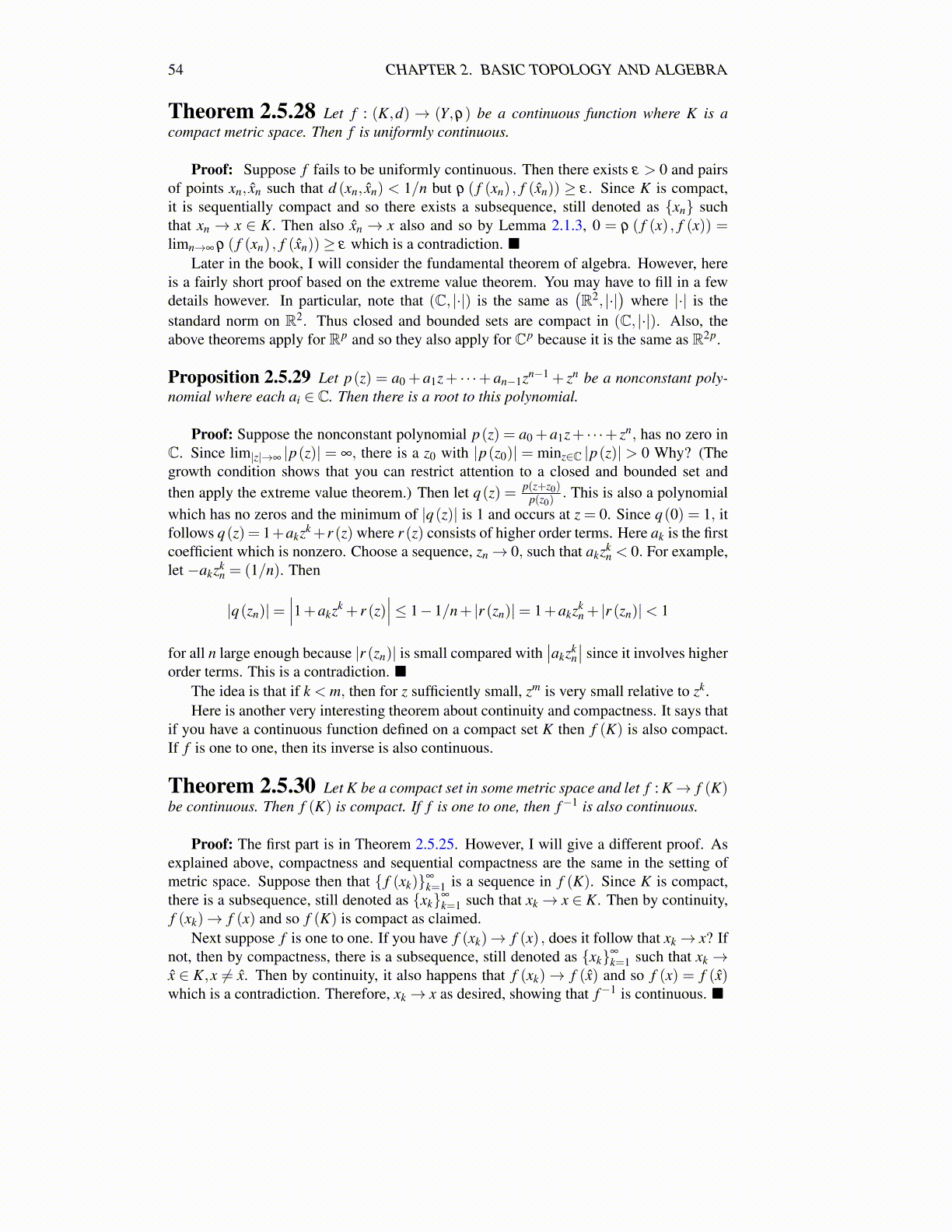
54 CHAPTER 2. BASIC TOPOLOGY AND ALGEBRA
Theorem 2.5.28 Let f : (K,d) → (Y,ρ) be a continuous function where K is acompact metric space. Then f is uniformly continuous.
Proof: Suppose f fails to be uniformly continuous. Then there exists ε > 0 and pairsof points xn, x̂n such that d (xn, x̂n) < 1/n but ρ ( f (xn) , f (x̂n)) ≥ ε . Since K is compact,it is sequentially compact and so there exists a subsequence, still denoted as {xn} suchthat xn → x ∈ K. Then also x̂n → x also and so by Lemma 2.1.3, 0 = ρ ( f (x) , f (x)) =limn→∞ ρ ( f (xn) , f (x̂n))≥ ε which is a contradiction. ■
Later in the book, I will consider the fundamental theorem of algebra. However, hereis a fairly short proof based on the extreme value theorem. You may have to fill in a fewdetails however. In particular, note that (C, |·|) is the same as
(R2, |·|
)where |·| is the
standard norm on R2. Thus closed and bounded sets are compact in (C, |·|). Also, theabove theorems apply for Rp and so they also apply for Cp because it is the same as R2p.
Proposition 2.5.29 Let p(z) = a0 + a1z+ · · ·+ an−1zn−1 + zn be a nonconstant poly-nomial where each ai ∈ C. Then there is a root to this polynomial.
Proof: Suppose the nonconstant polynomial p(z) = a0 +a1z+ · · ·+ zn, has no zero inC. Since lim|z|→∞ |p(z)| = ∞, there is a z0 with |p(z0)| = minz∈C |p(z)| > 0 Why? (Thegrowth condition shows that you can restrict attention to a closed and bounded set andthen apply the extreme value theorem.) Then let q(z) = p(z+z0)
p(z0). This is also a polynomial
which has no zeros and the minimum of |q(z)| is 1 and occurs at z = 0. Since q(0) = 1, itfollows q(z) = 1+akzk+r (z) where r (z) consists of higher order terms. Here ak is the firstcoefficient which is nonzero. Choose a sequence, zn→ 0, such that akzk
n < 0. For example,let −akzk
n = (1/n). Then
|q(zn)|=∣∣∣1+akzk + r (z)
∣∣∣≤ 1−1/n+ |r (zn)|= 1+akzkn + |r (zn)|< 1
for all n large enough because |r (zn)| is small compared with∣∣akzk
n∣∣ since it involves higher
order terms. This is a contradiction. ■The idea is that if k < m, then for z sufficiently small, zm is very small relative to zk.Here is another very interesting theorem about continuity and compactness. It says that
if you have a continuous function defined on a compact set K then f (K) is also compact.If f is one to one, then its inverse is also continuous.
Theorem 2.5.30 Let K be a compact set in some metric space and let f : K→ f (K)be continuous. Then f (K) is compact. If f is one to one, then f−1 is also continuous.
Proof: The first part is in Theorem 2.5.25. However, I will give a different proof. Asexplained above, compactness and sequential compactness are the same in the setting ofmetric space. Suppose then that { f (xk)}∞
k=1 is a sequence in f (K). Since K is compact,there is a subsequence, still denoted as {xk}∞
k=1 such that xk→ x ∈ K. Then by continuity,f (xk)→ f (x) and so f (K) is compact as claimed.
Next suppose f is one to one. If you have f (xk)→ f (x) , does it follow that xk→ x? Ifnot, then by compactness, there is a subsequence, still denoted as {xk}∞
k=1 such that xk →x̂ ∈ K,x ̸= x̂. Then by continuity, it also happens that f (xk)→ f (x̂) and so f (x) = f (x̂)which is a contradiction. Therefore, xk→ x as desired, showing that f−1 is continuous. ■